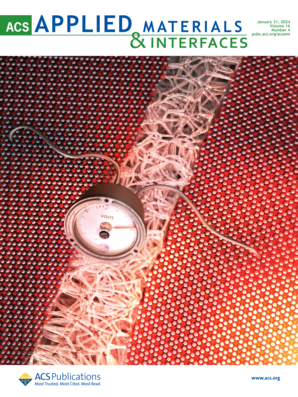Ni/Zn-Anchored/N-Doped Porous Carbon Microtubes Derived from Palm Threads for High-Performance Li–S Batteries
IF 8.3
2区 材料科学
Q1 MATERIALS SCIENCE, MULTIDISCIPLINARY
引用次数: 0
Abstract
Nitrogen-doped porous carbon microtubes embedded with Ni/Zn catalytic sites (NiZn-NPCT) are constructed from palm threads and can be used as both a S cathodic host and a separator modifier for advanced lithium–sulfur batteries. NiZn-NPCT possesses unique interconnected porous tunnels and abundantly exposed active sites, which increase the affinity for lithium polysulfides (LiPSs) and thus inhibit the shuttle effect. The kinetic studies indicate that NiZn-NPCT can accelerate the redox transformation of sulfur species. The battery assembled with the NiZn-NPCT-modified separator achieves high initial discharge capacities of 1220 and 409.1 mAh g–1 at 0.1C and 5C, respectively, with good cycling stability (418.1 mAh g–1 after 500 cycles at 1C). In addition, with a higher sulfur/NiZn-NPCT mass ratio (9:1), the battery still exhibited high initial discharge capacities of 1234.4 (0.1C) and 551.3 mAh g–1 (5C). This study offers an effective strategy to utilize renewable biomass with a unique microstructure and realize high-performance Li–S batteries.

高性能Li-S电池用棕榈丝制备的Ni/ zn锚定/ n掺杂多孔碳微管
以棕榈丝为材料制备了含Ni/Zn催化位点的氮掺杂多孔碳微管(NiZn-NPCT),可作为先进锂硫电池的S阴极载体和分离器改性剂。NiZn-NPCT具有独特的相互连接的多孔通道和大量暴露的活性位点,这增加了对锂多硫化物(LiPSs)的亲和力,从而抑制了穿梭效应。动力学研究表明,NiZn-NPCT能加速硫的氧化还原转化。使用nizn - npct修饰的隔板组装的电池在0.1C和5C下的初始放电容量分别为1220和409.1 mAh g-1,并且具有良好的循环稳定性(在1C下循环500次后为418.1 mAh g-1)。此外,在较高的硫/NiZn-NPCT质量比(9:1)下,电池仍具有较高的初始放电容量,分别为1234.4 (0.1C)和551.3 mAh g-1 (5C)。该研究为利用具有独特微观结构的可再生生物质,实现高性能锂硫电池提供了有效的策略。
本文章由计算机程序翻译,如有差异,请以英文原文为准。
求助全文
约1分钟内获得全文
求助全文
来源期刊

ACS Applied Materials & Interfaces
工程技术-材料科学:综合
CiteScore
16.00
自引率
6.30%
发文量
4978
审稿时长
1.8 months
期刊介绍:
ACS Applied Materials & Interfaces is a leading interdisciplinary journal that brings together chemists, engineers, physicists, and biologists to explore the development and utilization of newly-discovered materials and interfacial processes for specific applications. Our journal has experienced remarkable growth since its establishment in 2009, both in terms of the number of articles published and the impact of the research showcased. We are proud to foster a truly global community, with the majority of published articles originating from outside the United States, reflecting the rapid growth of applied research worldwide.
 求助内容:
求助内容: 应助结果提醒方式:
应助结果提醒方式:


